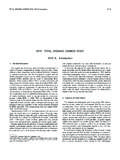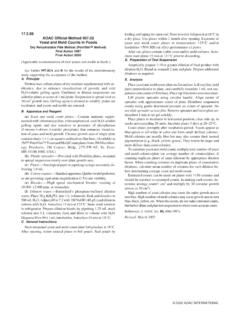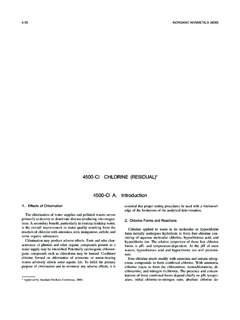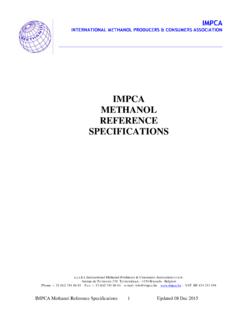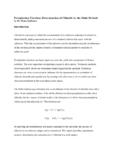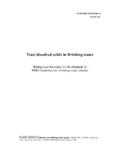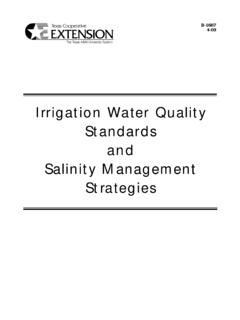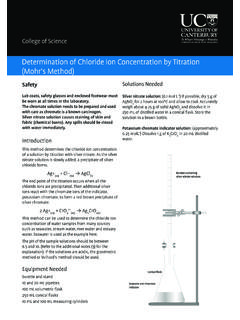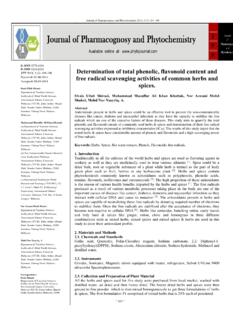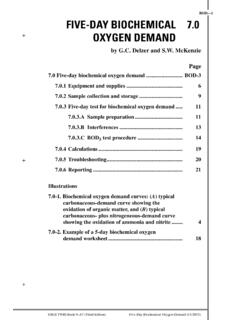Transcription of 2540 SOLIDS* 2540 A. Introduction - Edge Analytical
1 2540 SOLIDS* 2540 A. IntroductionSolids refer to matter suspended or dissolved in water orwastewater. Solids may affect water or effluent quality adverselyin a number of ways. Waters with high dissolved solids generallyare of inferior palatability and may induce an unfavorable phys-iological reaction in the transient consumer. For these reasons, alimit of 500 mg dissolved solids/L is desirable for drinkingwaters. Highly mineralized waters also are unsuitable for manyindustrial applications. Waters high in suspended solids may beesthetically unsatisfactory for such purposes as bathing. Solidsanalyses are important in the control of biological and physicalwastewater treatment processes and for assessing compliancewith regulatory agency wastewater effluent Total solids is the term applied to the material residue left inthe vessel after evaporation of a sample and its subsequentdrying in an oven at a defined temperature.
2 Total solids includes total suspended solids, the portion of total solids retained by afilter, and total dissolved solids, the portion that passes type offilter holder, the pore size, porosity, area, and thick-ness of thefilter and the physical nature, particle size, and amountof material deposited on thefilter are the principal factors affectingseparation of suspended from dissolved solids. dissolved solids isthe portion of solids that passes through afilter of m (orsmaller) nominal pore size under specified conditions. Suspendedsolids is the portion retained on thefilter. Fixed solids is the term applied to the residue of total,suspended, or dissolved solids after heating to dryness for aspecified time at a specified temperature.
3 The weight loss onignition is called volatile solids. Determinations offixed andvolatile solids do not distinguish precisely between inorganicand organic matter because the loss on ignition is not confined toorganic matter. It includes losses due to decomposition or vol-atilization of some mineral salts. Better characterization of or-ganic matter can be made by such tests as total organic carbon(Section 5310), BOD (Section 5210), and COD (Section 5220). Settleable solids is the term applied to the material settlingout of suspension within a defined period. It may includefloatingmaterial, depending on the technique ( ).
4 Of Error and VariabilitySampling, subsampling, and pipeting two-phase or three-phasesamples may introduce serious errors. Make and keep such sampleshomogeneous during transfer. Use special handling to insure sampleintegrity when subsampling. Mix small samples with a magneticstirrer. If suspended solids are present, pipet with wide-bore part of a sample adheres to the sample container, consider this inevaluating and reporting results. Some samples dry with the forma-tion of a crust that prevents water evaporation; special handling isrequired to deal with this. Avoid using a magnetic stirrer withsamples containing magnetic temperature at which the residue is dried has an importantbearing on results, because weight losses due to volatilization oforganic matter, mechanically occluded water, water of crystalli-zation, and gases from heat-induced chemical decomposition, aswell as weight gains due to oxidation, depend on temperatureand time of heating.
5 Each sample requires close attention todesiccation after drying. Minimize opening desiccator becausemoist air enters. Some samples may be stronger desiccants thanthose used in the desiccator and may take on dried at 103 to 105 C may retain not only water ofcrystallization but also some mechanically occluded water. Lossof CO2will result in conversion of bicarbonate to of organic matter by volatilization usually will be veryslight. Because removal of occluded water is marginal at thistemperature, attainment of constant weight may be very dried at 180 2 C will lose almost all mechanicallyoccluded water.
6 Some water of crystallization may remain, es-pecially if sulfates are present. Organic matter may be lost byvolatilization, but not completely destroyed. Loss of CO2resultsfrom conversion of bicarbonates to carbonates and carbonatesmay be decomposed partially to oxides or basic salts. Somechloride and nitrate salts may be lost. In general, evaporating anddrying water samples at 180 C yields values for dissolved solidscloser to those obtained through summation of individuallydetermined mineral species than the dissolved solids valuessecured through drying at the lower rinsefilters andfiltered solids and to clean labware useType III water.
7 Special samples may require a higher qualitywater; see Section for residues high in oil or grease may be questionablebecause of the difficulty of drying to constant weight in areasonable aid in quality assurance, analyze samples in duplicate. Drysamples to constant weight if possible. This entails multipledrying-cooling-weighing cycles for each performed for some special purposes may demanddeviation from the stated procedures to include an unusual constit-uent with the measured solids. Whenever such variations of tech-nique are introduced, record and present them with the Handling and PreservationUse resistant-glass or plastic bottles, provided that the materialin suspension does not adhere to container walls.
8 Begin analysisas soon as possible because of the impracticality of preservingthe sample. Refrigerate sample at 4 C up to the time of analysisto minimize microbiological decomposition of solids. Preferablydo not hold samples more than 24 h. In no case hold sample morethan 7 d. Bring samples to room temperature before analysis.* Approved by Standard Methods Committee, Task Group: 20th Edition Brannon H. Wilder (chair), Harold S. Costa,Christine M. Kosmowski, William E. (2540) of MethodMethods B through F are suitable for the determination ofsolids in potable, surface, and saline waters, as well as domesticand industrial wastewaters in the range up to 20 000 G is suitable for the determination of solids in sedi-ments, as well as solid and semisolid materials produced duringwater and wastewater BibliographyTHERIAULT, & WAGENHALS.
9 1923. Studies of representativesewage Health ENVIRONMENTALPROTECTIONAGENCY. 1979. Methods for ChemicalAnalysis of Water and Wastes. Publ. 600/4-79-020, rev. Mar. Monitoring and Support Lab., EnvironmentalProtection Agency, Cincinnati, B. Total Solids Dried at 103 105 Discussiona. Principle:A well-mixed sample is evaporated in a weigheddish and dried to constant weight in an oven at 103 to 105 C. Theincrease in weight over that of the empty dish represents the totalsolids. The results may not represent the weight of actual dis-solved and suspended solids in wastewater samples (see above).
10 B. Interferences:Highly mineralized water with a significantconcentration of calcium, magnesium, chloride , and/or sulfate maybe hygroscopic and require prolonged drying, proper desiccation,and rapid weighing. Exclude large,floating particles or submergedagglomerates of nonhomogeneous materials from the sample if it isdetermined that their inclusion is not desired in thefinal visiblefloating oil and grease with a blender before with-drawing a sample portion for analysis. Because excessive residue inthe dish may form a water-trapping crust, limit sample to no morethan 200 mg residue (see ). Evaporating dishes:Dishes of 100-mL capacity made ofone of the following materials:1) Porcelain, 90-mm ) Platinum Generally satisfactory for all ) High-silica glass.

